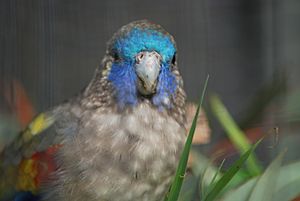Naretha bluebonnet facts for kids
Quick facts for kids Naretha bluebonnet |
|
|---|---|
 |
|
| Naretha Bluebonnet | |
| Scientific classification | |
| Genus: |
Northiella
|
| Species: |
narethae
|
The Naretha bluebonnet (Northiella narethae) is a type of parrot found in Australia. It's one of two species in the Northiella group of birds. For a long time, people thought it was just a different kind of eastern bluebonnet, but now we know it's its own unique species.
Contents
Discovery and History
This special parrot was first described in 1921 by a man named Henry Luke White. He was a wealthy farmer and a well-known bird expert. White had an assistant, Frederick Lawson Whitlock, who was exploring the western Nullarbor Plain. Whitlock met a railway worker who had a pet parrot that looked like no other bird he knew. This pet bird had been caught near a place called Naretha.
Later, Henry White himself stopped in Zanthus to talk to the railway worker. He managed to get three bird skins (which are preserved bird bodies used for study) and took them to a museum in Melbourne.
For many years, the Naretha bluebonnet was grouped with other parrots like the Red-rumped parrot. However, the Naretha bluebonnet is quite different. For example, male and female Naretha bluebonnets look very similar in color, unlike many other parrots where the males and females have very different colors. Also, bluebonnets have special pointed tips on their main flight feathers. They also move in a unique jerky, bobbing way, especially when they are excited or scared, and their calls are very distinct.
Because of these differences, the Naretha parrot was later considered a subspecies of the eastern bluebonnet. But in 2015, a scientific study looked at the birds' DNA. This study confirmed that the Naretha bluebonnet was genetically different enough to be considered its own separate species again.
What They Look Like
The Naretha bluebonnet is a bit smaller than the eastern bluebonnet. It's usually about 28 cm (11 in) long. Its legs and feet are dark grey, and its eyes are dark brown.
The adult male Naretha bluebonnet has a cool two-tone face. The area above its eyes and its forehead are a lighter green-blue. The rest of its face is a purplish-blue. Its head, neck, and chest are light grey-brown with some pale streaks and spots. Its back is olive-grey. The belly and thighs are a solid yellow, with red only found under its tail. The feathers on its wings are a mix of blue, red, and yellow-olive. The middle tail feathers have a light blue tint.
The adult female Naretha bluebonnet is a bit duller in color. Her forehead has a less bright blue, and her wings and tail have less color. She also doesn't have any orange tint on her belly. Females are slightly smaller, usually around 26 cm (10 in) long.
Where They Live and Their Home
The Naretha bluebonnet used to be common in the dry Nullarbor Plain region of Australia. However, it became rarer during the 1900s. These birds live in a very specific area, mostly on the border between Western Australia and South Australia. This means they are endemic to that region, which means they are found only there.
Naretha bluebonnets live in what are called Myall woodlands. These are forests mostly made up of a type of tree called Acacia. Their home area is large and quite isolated. You might see them more often near water troughs that are used for farm animals, as water can be hard to find in their dry habitat.
Reproduction
Naretha bluebonnets start their breeding season early, laying their first eggs by mid-July. They build their nests in hollows found in she-oak trees. The eggs are oval-shaped and have a matte white color.
In the wild, they usually choose Casuarina trees for nesting. These trees often have small knot holes that the birds use as entrances. However, people have also seen female bluebonnets coming out of tree cracks and splits, not just actual holes. It's thought that there aren't many suitable trees with perfect holes in the Naretha bluebonnet's home, which might be why they squeeze into smaller spaces.
Images for kids
See also
 In Spanish: Perico de Naretha para niños
In Spanish: Perico de Naretha para niños





